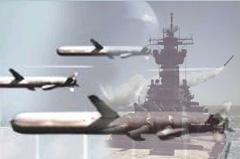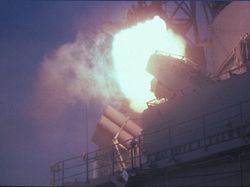Fri, Oct 01, 2004
Navy Welcomes New Ordnance To The Fleet
 The US Navy Wednesday welcomed
Raytheon Company's Tomahawk Block IV cruise missile into its
arsenal at a fleet introduction ceremony in the Pentagon. The Block
IV officially achieved initial operating capability (IOC) on May
27, 2004, with the loading of the first missile onboard USS Stethem
(DDG-63), a guided missile destroyer.
The US Navy Wednesday welcomed
Raytheon Company's Tomahawk Block IV cruise missile into its
arsenal at a fleet introduction ceremony in the Pentagon. The Block
IV officially achieved initial operating capability (IOC) on May
27, 2004, with the loading of the first missile onboard USS Stethem
(DDG-63), a guided missile destroyer.
"The Block IV Tomahawk provides a substantial battlefield edge
to our warfighters," said Navy Capt. Bob Novak, Tomahawk
All-Up-Round program manager. "It is a great day for the Navy to
formally celebrate the hard work of the Navy-Raytheon team that
enabled the fleet introduction of this revolutionary weapon, whose
flexible targeting and loitering capabilities build on the
tremendous 32-year tradition and success of the legacy Tomahawk
program."
"Raytheon is proud to provide the Navy with this new weapon with
expanded warfighting capabilities that position weapons as nodes in
the integrated network of the future battlespace," said Louise L.
Francesconi, Raytheon Missile Systems president. "The Block IV
Tomahawk is the result of the collective commitment of the Navy and
Raytheon to provide affordable, operational capabilities for
critical long-range, precision strike missions."
Block IV Tomahawk is the centerpiece of the Navy's new Tomahawk
Baseline IV Weapons System. The system integrates the Block IV
missile with improved mission planning and platform weapons control
capabilities. This latest version of the Navy's surface- and
submarine-launched precision strike standoff weapon incorporates
innovative technologies to provide unprecedented operational
capabilities while dramatically reducing acquisition, operations
and support costs. The Block IV costs less than half the price of a
newly built Block III missile. Additionally, the Block IV missile
will have a 15-year warranty and recertification cycle, compared to
the Block III variant's eight-year recertification cycle.
 The new capabilities that Block IV
Tomahawk brings to the Navy's sea strike capability are derived
from the missile's two-way satellite data link that enables the
missile to respond to changing battlefield conditions. The strike
controller can "flex" the missile in flight to preprogrammed
alternate targets or redirect it to a new target. This targeting
flexibility includes the capability to loiter over the battlefield
awaiting a more critical target. The missile can also transmit
battle damage indication imagery and missile health and status
messages via the satellite data link. For the first time, firing
platforms will have the capability to plan and execute Global
Positioning System-only missions. Block IV will also introduce an
improved anti-jam GPS receiver for enhanced mission
performance.
The new capabilities that Block IV
Tomahawk brings to the Navy's sea strike capability are derived
from the missile's two-way satellite data link that enables the
missile to respond to changing battlefield conditions. The strike
controller can "flex" the missile in flight to preprogrammed
alternate targets or redirect it to a new target. This targeting
flexibility includes the capability to loiter over the battlefield
awaiting a more critical target. The missile can also transmit
battle damage indication imagery and missile health and status
messages via the satellite data link. For the first time, firing
platforms will have the capability to plan and execute Global
Positioning System-only missions. Block IV will also introduce an
improved anti-jam GPS receiver for enhanced mission
performance.
The Navy and Raytheon have entered into a five-year multi-year
procurement contract to replenish Tomahawk inventory at the most
affordable cost. The Tomahawk missile is the Navy's weapon of
choice for critical, long-range precision strike missions against
high value, heavily defended targets.
More News
“While legendary World War II aircraft such as the Corsair and P-51 Mustang still were widely flown at the start of the Korean War in 1950, a new age of jets rapidly came to >[...]
Decision Altitude (DA) A specified altitude (mean sea level (MSL)) on an instrument approach procedure (ILS, GLS, vertically guided RNAV) at which the pilot must decide whether to >[...]
Aero Linx: National Aviation Safety Foundation (NASF) The National Aviation Safety Foundation is a support group whose objective is to enhance aviation safety through educational p>[...]
Also: Cal Poly Aviation Club, $$un Country, Arkansas Aviation Academy, Teamsters Local 2118 In response to two recent general aviation accidents that made national headlines, more >[...]
“The FAA is tasked with ensuring our skies are safe, and they do a great job at it, but there is something about the system that is holding up the medical process. Obviously,>[...]
 Aero-News: Quote of the Day (04.28.25)
Aero-News: Quote of the Day (04.28.25) ANN's Daily Aero-Term (04.28.25): Decision Altitude (DA)
ANN's Daily Aero-Term (04.28.25): Decision Altitude (DA) ANN's Daily Aero-Linx (04.28.25)
ANN's Daily Aero-Linx (04.28.25) Airborne-Flight Training 04.24.25: GA Refocused, Seminole/Epic, WestJet v TFWP
Airborne-Flight Training 04.24.25: GA Refocused, Seminole/Epic, WestJet v TFWP Aero-News: Quote of the Day (04.29.25)
Aero-News: Quote of the Day (04.29.25)




